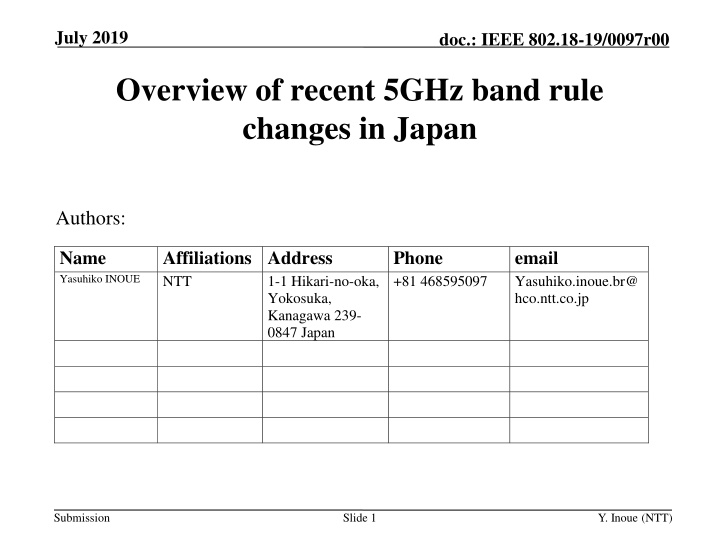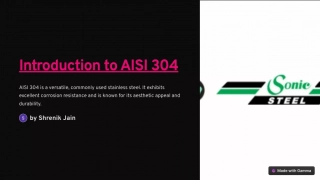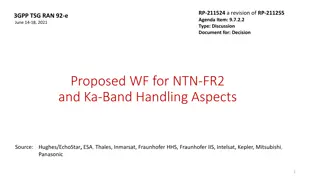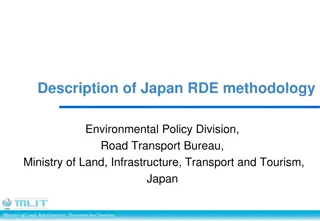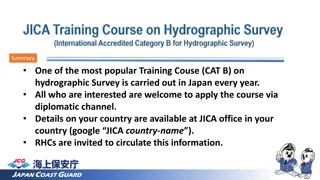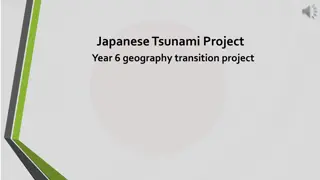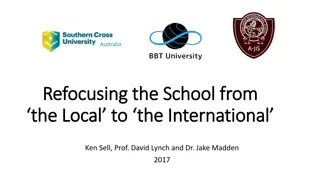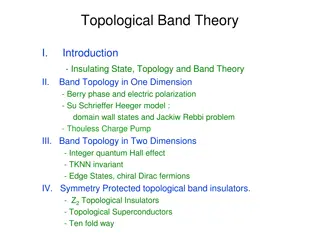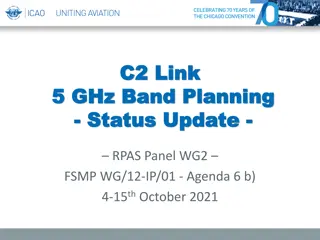Overview of recent 5GHz band rule changes in Japan
This document provides an overview of recent rule changes in the 5GHz band in Japan to allow high-efficiency wireless LANs. Changes include new rules for channel allocation, occupied channel bandwidth requirements, radio burst length, and radar detection criteria. The adjustments aim to accommodate next-generation wireless technologies and enhance spectrum utilization efficiency.
Uploaded on Feb 15, 2025 | 6 Views
Download Presentation

Please find below an Image/Link to download the presentation.
The content on the website is provided AS IS for your information and personal use only. It may not be sold, licensed, or shared on other websites without obtaining consent from the author.If you encounter any issues during the download, it is possible that the publisher has removed the file from their server.
You are allowed to download the files provided on this website for personal or commercial use, subject to the condition that they are used lawfully. All files are the property of their respective owners.
The content on the website is provided AS IS for your information and personal use only. It may not be sold, licensed, or shared on other websites without obtaining consent from the author.
E N D
Presentation Transcript
July 2019 doc.: IEEE 802.18-19/0097r00 Overview of recent 5GHz band rule changes in Japan Authors: Name Yasuhiko INOUE Affiliations Address NTT Phone +81 468595097 email Yasuhiko.inoue.br@ hco.ntt.co.jp 1-1 Hikari-no-oka, Yokosuka, Kanagawa 239- 0847 Japan Submission Slide 1 Y. Inoue (NTT)
July 2019 doc.: IEEE 802.18-19/0097r00 Background MIC Japan was considering rule changes in 5 GHz band to allow next generation high efficiency wireless LANs New rules Channel 144 is now available for low power data communication systems including wireless LANs. Requirements for the occupied channel bandwidth and spectrum mask are modified to allow 802.11ax signal. So called 4 ms rule is changed. Requirements for radar detection in the 5.3 GHz band are modified. The new rule is announced on July 11th and is effective now. Submission Slide 2 Y. Inoue (NTT)
July 2019 doc.: IEEE 802.18-19/0097r00 Channel 144 The channel 144 is now available for low power data communication system including WLANs. One additional channel for 20 MHz, 40 MHz and 80 MHz channels. Three additional combinations for the 80 + 80 MHz channelization. 5.15 5.35 5.47 5.73 5.2 5.3 5.5 5.7 5.6 GHz 20 MHz channels 36 40 44 48 52 56 60 64 100104 108 112 116120 124 128 132136 140 144 40 MHz channels 38 46 54 62 102 110 118 126 134 142 80 MHz channels 138 42 58 106 122 160 MHz channels 50 114 Submission Slide 3 Y. Inoue (NTT)
July 2019 doc.: IEEE 802.18-19/0097r00 Occupied channel bandwidth Requirements for the occupied channel bandwidths are relaxed to accommodate new OFDM signal of 802.11ax. Submission Slide 4 Y. Inoue (NTT)
July 2019 doc.: IEEE 802.18-19/0097r00 Radio burst length/Effective duration of the carrier sense There have been technical requirements for the length of radio burst and effective duration of carrier sense, so called 4 ms rule. The length of a radio burst must be less than of equal to 4 ms. A device has to do carrier sense if more than 4 ms had passed since previous carrier sense. This carrier sense can be omitted if 4 ms has not passed since previous CS Length <= 4 ms Radio Burst Radio Burst CS CS Ack Ack Now, 4 ms is relaxed to 8 ms. Submission Slide 5 Y. Inoue (NTT)
July 2019 doc.: IEEE 802.18-19/0097r00 Requirements for DFS in 5.3 GHz band New pulse pattern for WLAN to detect is defined in terms of Minimum and maximum values of the pulse width (W), minimum and maximum values of pulse repetition frequency (PRF), number of pulses in a period, etc. Future pulse pattern of the new weather radar is still under discussion. The condition of traffic load during in service monitoring is relaxed from 50% to 30% (similar to the requirement of ETSI). There is mitigation period of 1 year to adopt new radar detection scheme. 1/PRF T1 T2 W2 W1 Submission Slide 6 Y. Inoue (NTT)
July 2019 doc.: IEEE 802.18-19/0097r00 Reference 1. MIC Web site, Technical Requirements for the next generation high efficiency wireless LANs, http://www.soumu.go.jp/menu_news/s- news/02kiban12_04000251.html (in Japanese) Submission Slide 7 Y. Inoue (NTT)
